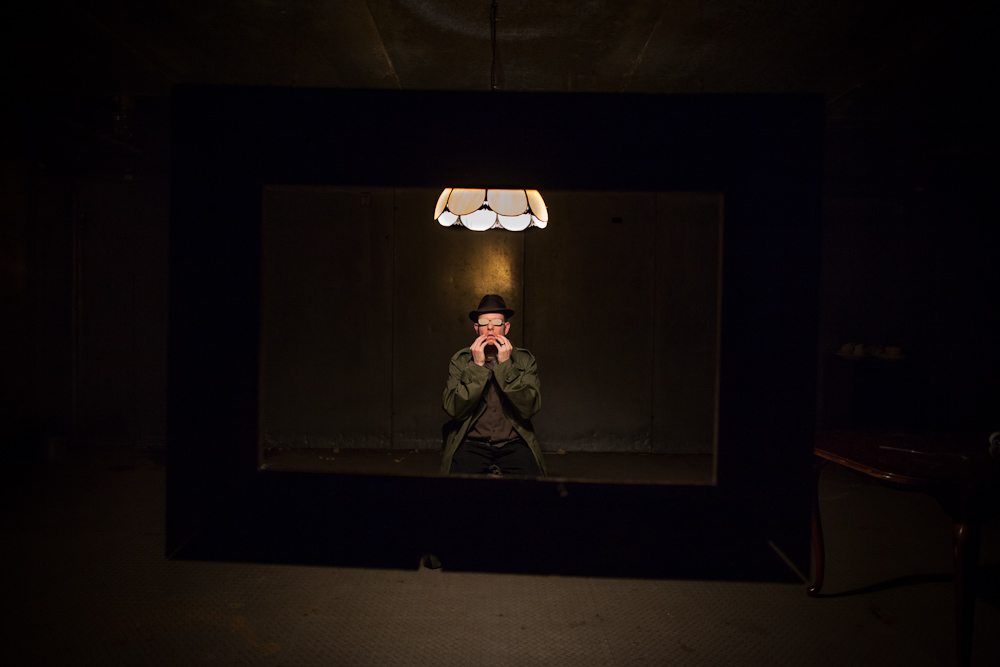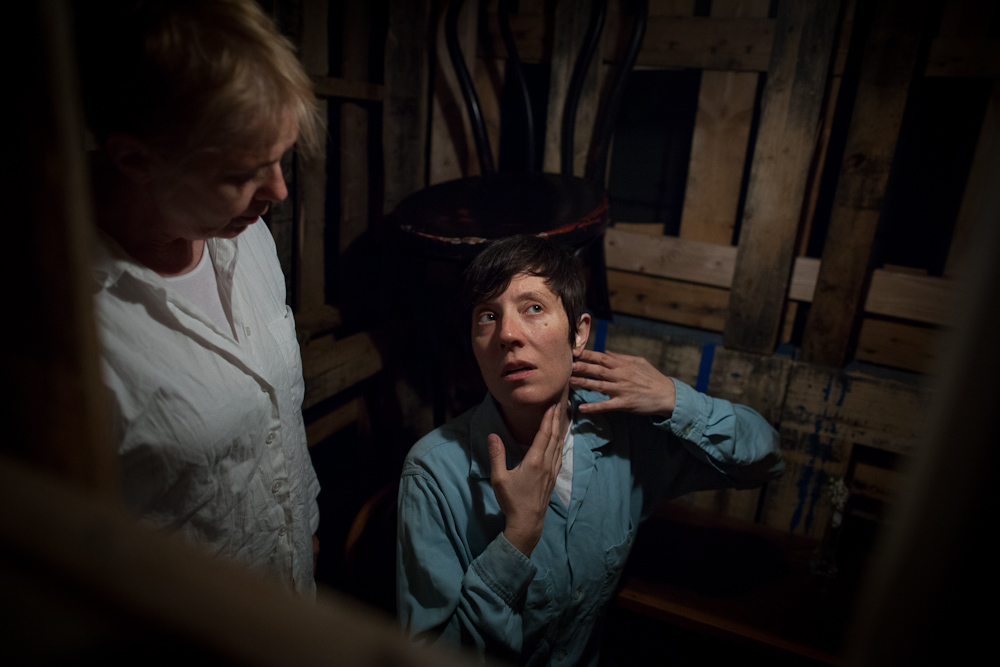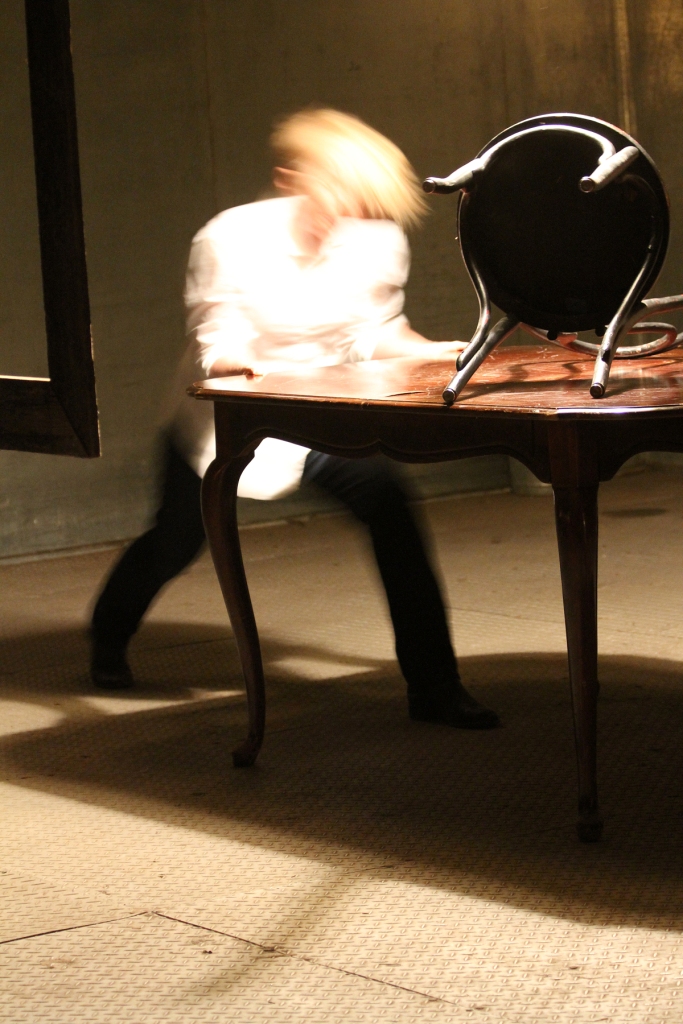A Double-Dip into “Black Water” – Camille LeFevre
We're running two essays on Skewed Visions' new site-based performance, BLACK WATER, showing in an empty storefront on University Avenue through June 2. Read on for Camille's take on the work's disquieting insight into place, seeing and being seen.



WHEN A PERFORMANCE IS BILLED AS “SITE-SPECIFIC” or, in the case of Skewed Visions’ new work, as a “site-based performance,” then one logical point of entry is a contemplation of the site itself. Black Water, created by and featuring Charles Campbell, takes place inside and around an empty storefront on University Avenue in St. Paul; until Central Corridor light-rail construction began, it housed Spiro’s Mediterranean Market, and before that, the building was home to the Summit Brewing Company.
This site, as it happens, is in my neighborhood. So, while walking from my house to the former market for the first public performance of Black Water, I paid particular attention to my surroundings. I peered into the windows of Swag and Succotash (two second-hand/vintage shops along the way). I noted the textures and historicism of the massive brick buildings along the avenue; I negotiated the temporary walkways put in place during light rail construction. I recalled that where the shiny Carleton Artist Lofts and its higher-end sister building, The Lyric, now stand, there was once the decidedly un-shiny Johnny’s Bar, notable for its outstanding beer selection.
Along my route, stapled to utility poles, was a varied selection of the stencil-and-spray-paint-on-cardboard signs that have been appearing in the neighborhood since winter. The artist is unknown and impressively stealthy. I’ve passed an untagged telephone pole only to, 20 minutes later, pass by it again and see a new sign. “Free everyone,” marked with an anarchist symbol, is the most ubiquitous sign. Also: “Corporations Lie, People Die.” Another popular motif features a television set with “Trust Me” or “I Lie to You” stenciled on its screen. The signs are guerilla. Some are worth collecting (as a few neighbors have done), others are disturbing. (Interestingly, the occasionally appearing stencil of Obama, with “I Lie to You” at the bottom, never stays up more than a couple hours — the neighborhood is not only liberal, but progressive.) The signs are declarative and argumentative, but they don’t typically invite engagement. An exception, perhaps, is this Orwellian proclamation: “1984 was not supposed to be an instruction manual.” This sign’s message forces the reader to consider who, at that moment, might be watching them.
The sign also served as an eerie prelude to Campbell’s immersive investigation of power, memory, literature, war, and privacy (and the lack thereof) — with drone. In an article on the rise of the drone written for the New Yorker, reporter Nick Paumgarten offers this 1999 quote from Scott McNealy (then of Sun Microsystems) about the growth of surveillance: “You have zero privacy anyway. Get over it.”
Well, Campbell’s not over it. Black Water, perhaps more than anything else, is about seeing, not seeing, and perception. The performance begins inside the former market/brewery’s cold-storage locker: a metal room (walls, floors, ceiling) that goes inky black when our guide switches off her flashlight. Campbell strikes a match and there he is, crammed into a corner, wearing a hat, long coat, and a pair of glasses with brown-paper lenses. “Death will come and will have your eyes,” Campbell intones, quoting from a poem by Cesare Pavese; the phrase is also the title of a series of photographs of old people in Italy taken by Mario Giacomelli. (Both of these were inspirational material for the piece).
As match after match loses its flame, we’re immersed in blackness and experience moments of sensory death. Suddenly a light switches on, illuminating an in-process domestic tableau fenestrated with an empty picture frame: Laurie Van Wieren, sets a table with impeccably understated movements and sometimes immobilized frustration; Megan Mayer, inexplicably and hilariously moves in the frame, flitting into ballet steps and gestures. This picture of domestic tranquility is cacophonously fractured — more than once. Campbell finds messages in his pancakes, like the paper fortunes in fortune cookies, which he reads aloud. (Other texts, noted in the program, include works by Baudrillard and Beckett, Austerlitz by W.G. Sebald, and news reports about U.S. drone strikes.) He also vocally holds an “A” (for anarchy? Austerlitz? angst?) for a very long time.
______________________________________________________
Chairs appear in a room that once housed beer vats: chairs of almost every style, type, and material, tossed about or hung from the ceiling, like the empty boots, helmets, or gloves of those killed in war.
______________________________________________________
The picture inverts and mutates: The audience moves to a loading dock, and we find a slatted box (made from wood pallets and designed by Irve Dell) housing Van Wieren, Mayer, and a small table. Here, the slats fragment the audience’s view and obscure our perception of what’s occurring inside the box (even if you walk right up to an opening and peer in). Next, as Campbell ushers the audience outside, he examines the building’s bricks, startling every so slightly as a glass-block wall lights up with sparkly colors; he looks through a window at Van Wieren and Mayer, tumbled in front of a mural picturing diners at a café on a Mediterranean coast.
As we move inside again, chairs — which have been in play throughout the work — become prominent, as the performers wrestle with the seats, legs, and backs. Campbell even takes a chair to bed with him as he talks about “fighting against that which is trying to help you.” The bed, in fact, references the one in Skewed Visions’ 2010 piece He Woke Up In A Strange Place Called Home And Although Looking For Bed He Kept Finding Death Instead; Campbell calls that work the second in a trilogy that began with the 2007 piece Strange Love (which took place in a coffin factory) and concludes with Black Water. More intriguing are the chairs that appear in a room that once housed beer vats: chairs of almost every style, type, and material, tossed about or hung from the ceiling, like the empty boots, helmets, or gloves of those killed in war.
Chairs, of course, are a frequent metaphor in literature, art, and performance. In Eugene Ionesco’s farce, The Chairs, a couple prepares seats for invisible guests (i.e., the audience, everyman/woman, humanity) waiting to hear an old man’s take on the meaning of life. Dancer, choreographer, and theater director David Gordon also famously used metal folding chairs as props and partners in many of his post-modern works, including Dancing Henry V, his condensed theatrical version of Shakespeare’s Henry V. (Gordon also directed a version of Ionesco’s play.) Last July, the Walker Art Center collected just over a thousand chairs in support of Chinese artist Ai Weiwei. Exhibited as 1,001 Chairs: An Observance in Honor of Silenced Voices, the piece was inspired by Ai’s Fairytale: 1001 Qing Dynasty Wooden Chairs. Throughout the world, the empty chair is a metaphor for loss, a symbol of grief, a conjuring of memory on the verge of being forgotten.
In the press materials, Campbell says, “There comes a point where we don’t recognize the world we are living in for what it is. We adapt to all sorts of crazy. Black Water is a little show trying hard to look at it all with fresh eyes: find out what this world is — who we are and what it means.” In challenging our expectations, thwarting our perceptions, and posing culturally resonant questions, Black Water, like so much site-specific work, de-familiarizes the everyday and affects a sense of the uncanny. Today I see my ever-changing neighborhood anew.
______________________________________________________
Related performance details and links:
Black Water by Skewed Visions, was created by Charles Campbell and features performances by Campbell and award-winners Megan Mayer and Laurie Van Wieren, wit design by Irve Dell, sound by Elliott Durko Lynch, lighting by Heidi Eckwall, and video by Kevin Obsatz. Black Water runs through June 2, showing Thursday – Saturday evenings at 8 pm in the empty storefront (formerly home to Mediterranean Market) at 2264 University Avenue, St. Paul. Tickets and additional info: http://www.skewedvisions.org/2012/05/black-water/
______________________________________________________
About the author: Camille LeFevre is an arts journalist and critic, and the author of The Dance Bible: The complete resource for aspiring dancers.